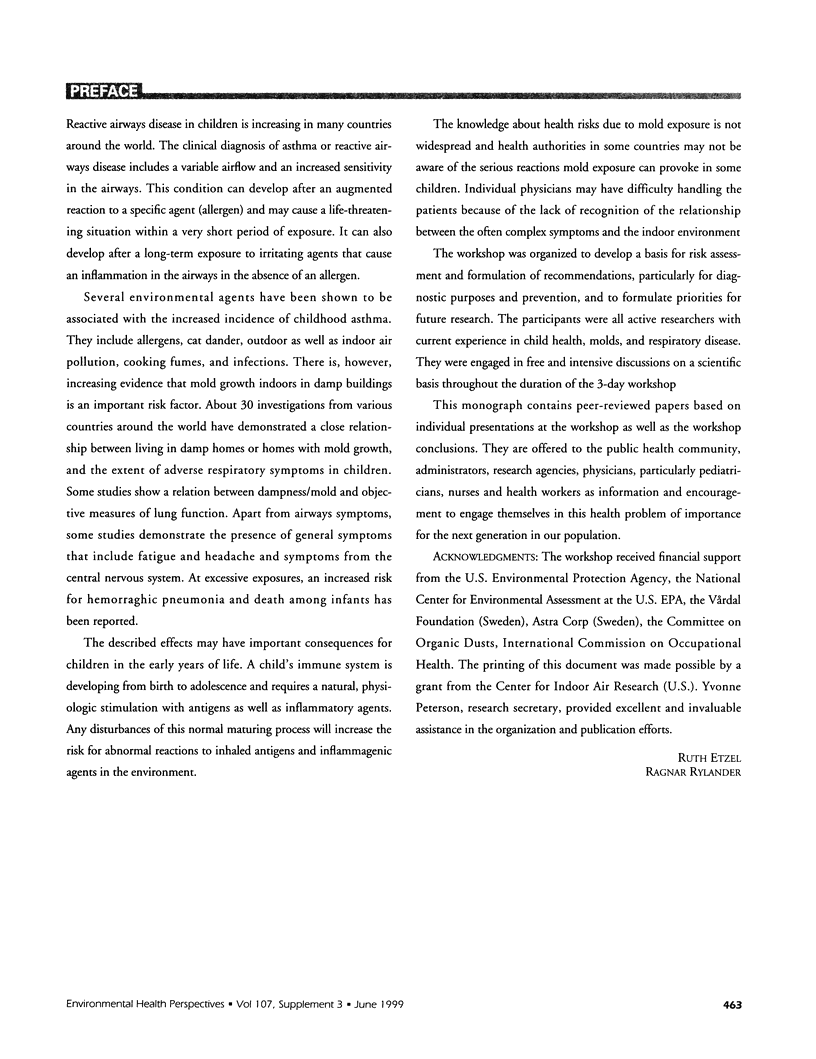Abstract
Reactive airways disease in children is increasing in many countries around the world. The clinical diagnosis of asthma or reactive airways disease includes a variable airflow and an increased sensitivity in the airways. This condition can develop after an augmented reaction to a specific agent (allergen) and may cause a life-threatening situation within a very short period of exposure. It can also develop after a long-term exposure to irritating agents that cause an inflammation in the airways in the absence of an allergen. (paragraph) Several environmental agents have been shown to be associated with the increased incidence of childhood asthma. They include allergens, cat dander, outdoor as well as indoor air pollution, cooking fumes, and infections. There is, however, increasing evidence that mold growth indoors in damp buildings is an important risk factor. About 30 investigations from various countries around the world have demonstrated a close relationship between living in damp homes or homes with mold growth, and the extent of adverse respiratory symptoms in children. Some studies show a relation between dampness/mold and objective measures of lung function. Apart from airways symptoms, some studies demonstrate the presence of general symptoms that include fatigue and headache and symptoms from the central nervous system. At excessive exposures, an increased risk for hemorraghic pneumonia and death among infants has been reported. (paragraph) The described effects may have important consequences for children in the early years of life. A child's immune system is developing from birth to adolescence and requires a natural, physiologic stimulation with antigens as well as inflammatory agents. Any disturbances of this normal maturing process will increase the risk for abnormal reactions to inhaled antigens and inflammagenic agents in the environment. (paragraph) The knowledge about health risks due to mold exposure is not widespread and health authorities in some countries may not be aware of the serious reactions mold exposure can provoke in some children. Individual physicians may have difficulty handling the patients because of the lack of recognition of the relationship between the often complex symptoms and the indoor environment (paragraph) The workshop was organized to develop a basis for risk assessment and formulation of recommendations, particularly for diagnostic purposes and prevention, and to formulate priorities for future research. The participants were all active researchers with current experience in child health, molds, and respiratory disease. They were engaged in free and intensive discussions on a scientific basis throughout the duration of the 3-day workshop (paragraph) This monograph contains peer-reviewed papers based on individual presentations at the workshop as well as the workshop conclusions. They are offered to the public health community, administrators, research agencies, physicians, particularly pediatricians, nurses and health workers as information and encouragement to engage themselves in this health problem of importance for the next generation in our population. (paragraph) Acknowledgments: The workshop received financial support from the U.S. Environmental Protection Agency, the National Center for Environmental Assessment at the U.S. EPA, the Vardal Foundation (Sweden), Astra Corp (Sweden), the Committee on Organic Dusts, International Commission on Occupational Health. The printing of this document was made possible by a grant from the Center for Indoor Air Research (U.S.). Yvonne Peterson, research secretary, provided excellent and invaluable assistance in the organization and publication efforts.
Full text
PDFPage 463



